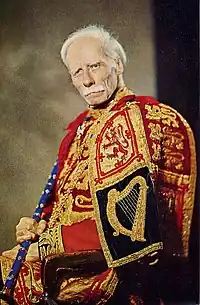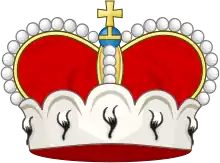The British nobility is made up of the peerage and the (landed) gentry. The nobility of its four constituent home nations has played a major role in shaping the history of the country, although the hereditary peerage now retain only the rights to stand for election to the House of Lords, dining rights there, position in the formal order of precedence, the right to certain titles, and the right to an audience (a private meeting) with the monarch. More than a third of British land is in the hands of aristocrats and traditional landed gentry.[1]
Peerage
The British nobility in the narrow sense consists of members of the immediate families of peers who bear courtesy titles or honorifics.[2] Members of the peerage carry the titles of duke, marquess, earl, viscount or baron. British peers are sometimes referred to generically as lords, although individual dukes are not so styled when addressed or by reference.
All modern British honours, including peerage dignities, are created directly by the Crown and take effect when letters patent are issued, affixed with the Great Seal of the Realm. The Sovereign is considered to be the fount of honour and, as "the fountain and source of all dignities cannot hold a dignity from himself",[3] cannot hold a British peerage.
Landed gentry
Descendants in the male line of peers and children of women who are peeresses in their own right, as well as baronets, knights, dames and certain other persons who bear no peerage titles, belong to the gentry, deemed members of the non-peerage nobility below whom they rank. The untitled nobility consists of all those who bear formally matriculated, or recorded, armorial bearings (a coat of arms).[2] CILANE[4] and the Sovereign Military Order of Malta[5] both consider armorial bearings as the main, if not sole, mark of nobility in Britain.
Other than their designation, such as Gentleman or Esquire, they enjoy only the privilege of a position in the formal orders of precedence in the United Kingdom. The largest portion of the British aristocracy has historically been the landed gentry, made up of baronets and the non-titled armigerous landowners whose families hailed from the medieval feudal class (referred to as gentlemen due to their income solely deriving from land ownership).
Non-hereditary nobility
It is often wrongly assumed that knighthoods and life peerages cannot grant hereditary nobility. The bestowal of a peerage or a knighthood is seen as due reason for a grant of arms by Garter King of Arms or Lord Lyon, and thus, those who make use of it attain hereditary nobility. The eldest son of a Knight and his eldest sons in perpetuity attain the rank of Esquire.
The only form of non-hereditary nobility in Great Britain is that associated with certain offices, which give the rank of Gentleman for the duration of tenure, or for life. Some offices and ranks also give the rank of Esquire for life.
Ennoblement
The Monarch grants Peerages, Baronetcies and Knighthoods (nowadays mostly Life Peerages and Knighthoods) to citizens of the United Kingdom and Commonwealth Realms at the advice of the Prime Minister. Honours lists are published regularly at important occasions.
Untitled nobility, i.e. gentility, being identical to armigerousness, falls into the jurisdiction of the College of Arms and Lyon Court. Part of the Monarch's fons honorum—the power to grant arms—has been de facto devolved to Garter King of Arms and Lord Lyon King of Arms, respectively. A grant of arms is in every regard equivalent to a patent of nobility on the Continent; depending on jurisdiction and circumstances it can be seen as either an act of ennoblement or a confirmation of nobility.
Thus, along with Belgium and Spain, the United Kingdom remains one of the few countries in which nobility is still granted and the nobility (except for the hereditary peerage and baronetage) does not form a closed, purely "historical" class.
History
Early English period
Early Anglo-Saxons used the Old English word eorl to distinguish nobles from the free, non-noble population called ceorls.[6] By the 8th century, the word gesith had replaced eorl as the common term for a nobleman. A gesith could be either an estate-holder or a retainer in a lord or king's comitatus.[7] By serving a lord (Old English: hlaford, literally "bread-giver"), gesith gained protection (mund) and rewards of gold and silver. Young nobles were raised with the sons of kings to someday become their gesith.[8]
In the 10th century, the word gesith was replaced with the word thegn.[7] In 1066, there were an estimated 5,000 thegns in England. Some of these were "kings thegns" serving in the royal household and others "lesser thegns", but all owned five or more hides of land. They were the mainstay of the local government and military. Thegns gave judgment in the shire court, and sheriffs were drawn from this class. For these reasons, historian David Carpenter described thegns as "the country gentry of Anglo-Saxon England".[9][10]
Above the gesith or thegn was the ealdorman. By the 9th century, this word meant any high-ranking royal official. With the development of the shire system, the meaning narrowed to a shire's chief secular officer. The ealdorman commanded the shire's fyrd (army) and co-presided with the bishop over the shire court. Typically, a single ealdorman was given charge of a group of shires (an ealdormanry), so there were around six or eight ealdormen at any one time. In the 11th century, while England was ruled by a Danish dynasty, the title changed from ealdorman to earl (related to Old English eorl and Old Norse jarl).[11] The earl was the most powerful secular magnate, second only to the king in authority. During Edward the Confessor's reign (1042–1066), there were four principal earldoms: Wessex, Mercia, Northumbria, and East Anglia.[12]
High-ranking members of the church hierarchy (archbishops, bishops and abbots) paralleled the secular aristocracy. The church's power derived from its spiritual authority as well as its virtual monopoly on education. Secular government depended on educated clergy to function, and prelates were important politicians and royal advisers. Bishops always took the leading role in the Witan, the councils of earls, thegns, and prelates that advised the king.[13]
Norman period (1066–1154)
The Norman Conquest of 1066 marked the creation of a new, French-speaking Anglo-Norman aristocracy with estates in both Normandy and England.[14] This cross-Channel aristocracy also included smaller groups originating from other parts of France, such as Brittany, Boulogne, and Flanders.[15]
When William I (r. 1066–1087) confiscated the property of the old Anglo-Saxon nobility, he kept 17 percent of the land as his royal demesne (now the Crown Estate). The rest was given to the Conqueror's companions and other followers. According to the Domesday Book of 1086, the rest of the land was distributed as follows:[16]
- 50 percent went to greater tenants-in-chief
- 25 percent went to the church
- 8 percent went to minor royal officials and lesser tenants-in-chief
Land was distributed according to the rules of feudalism. Vassals were granted fiefs in return for military service and counsel. These vassals were called tenants-in-chief because they held land directly from the king.[17] According to Domesday Book, there were 1,100 tenants-in-chief in 1086. Those with estates worth over £30 a year were considered the greater tenants-in-chief. Those with smaller estates were considered the lesser tenants-in-chief.[18]
The greater tenants-in-chief constituted the highest ranks of the Anglo-Norman aristocracy: earls and the king's barons . The Normans continued to use the title of earl and equated it with the title of count (Latin: comes) used in Normandy.[10] This was the only hereditary title before 1337,[19] and it was the most exclusive rank within the aristocracy. Between 1000 and 1300, there were never more than 25 extant earldoms at any one time.[20]
Below earls were the king's barons. Baron (Latin: baro) originally meant "man". In Norman England, the term came to refer to the king's greater tenants-in-chief. King's barons corresponded to king's thegns in the Anglo-Saxon hierarchy.[21] Baron was not yet a hereditary title but rather described a social status.[22]
The estate of an earl or baron was called an honour. Domesday Book identifies around 170 greater tenants-in-chief, and the ten wealthiest among them owned 25 percent of the land:[16]
- Robert of Mortain, the earl of Cornwall
- Odo of Bayeux, the earl of Kent
- William FitzOsbern, the earl of Hereford
- Roger de Montgomery, the earl of Shrewsbury
- William de Warenne, the earl of Surrey
- Hugh d'Avranches, the earl of Chester
- Eustace II, the count of Boulogne
- Richard fitz Gilbert
- Geoffrey of Coutances
- Geoffrey de Mandeville
Domesday Book also records around 6,000 under-tenants. Earls and barons granted land to their own vassals in a process called subinfeudation. Their most important vassals were honorial barons, who were of lesser status than king's barons . They corresponded to the lesser thegn of Anglo-Saxon England. Honorial barons were given manors in return for service and had their own tenants. For this reason, they were intermediate or mesne lords.[23][24] These could also be wealthy and powerful, with some eclipsing the lesser important king's barons.[25]
The lower ranks of the aristocracy included the landless younger sons of important families and wealthier knights (men who held substantial land by knight-service). Poorer knights (whose knight's fees were small) were likely excluded from the aristocracy.[26]
13th century
By 1300, the knightly class or gentry numbered around 3,000 landholders. Half of these were dubbed knights, while the other half were styled esquire.[27] The banneret was ranked below a baron but above a regular knight.[28] There was overlap between this group and the "lesser barons".[note 1]
The baronage (including barons, earls, and high-ranking churchmen) had a duty as tenants-in-chief to provide the king with advice when summoned to great councils.[30] In the 1200s, the great council evolved into Parliament, a representative body that increasingly asserted for itself the right to consent to taxation. Initially, participation in Parliament was still determined by one's status as a tenant-in-chief. Earls and greater barons received a writ of summons issued directly from the king, while lesser barons were summoned through the local sheriffs.[31] In the reign of Edward I (1272–1307), the first hereditary barons were created by writ. Overtime, baronies by writ became the main method of creating baronies, and baronies by tenure became obsolete.[32]
20th century
Non-hereditary positions began to be created again in 1867 for Law Lords. In 1958, the Life Peerages Act 1958 enabled (non-hereditary) life peers to sit in the House of Lords, and from then on the creation of hereditary peerages rapidly became obsolete, almost ceasing after 1964. This is only a convention, and was not observed by prime minister Margaret Thatcher, who asked the Queen to create three hereditary peerages (two of them, to men who had no heirs). Until changes in the twentieth century, only a proportion of those holding Scottish and Irish peerages were entitled by that title to sit in the House of Lords; these were nominated by their peers.
Until constitutional reforms soon after Tony Blair came to power (the House of Lords Act 1999), possession of a title in the peerage (except Irish) entitled its holder to a seat in the House of Lords. Since then, only 92 hereditary peers are entitled to sit in the House of Lords, of which 90 are elected by the hereditary peers by ballot and replaced on death. The two exceptions are the Earl Marshal (a position held by the Dukes of Norfolk), who is responsible for certain ceremonial functions on state occasions, and the Lord Great Chamberlain (a position held in gross and one of a number of persons can hold it), who serves as the monarch's representative in Parliament and accompanies them on certain state occasions; both are automatically entitled to sit in the House. Typically, those due to inherit a peerage—or indeed have done so, in recent times—have been educated at one of the major public schools, such as Eton, Radley, Oundle, Winchester or Harrow.
A member of the House of Lords cannot simultaneously be a member of the House of Commons. In 1960, Anthony Wedgwood Benn inherited his father's title as Viscount Stansgate. He fought and won the ensuing by-election, but was disqualified from taking his seat until the Peerage Act 1963 was passed enabling hereditary peers to renounce their titles. Titles, while often considered central to the upper class, are not always strictly so. Both Captain Mark Phillips and Vice-Admiral Sir Timothy Laurence, the respective first and second husbands of Princess Anne, do not hold peerages. Most members of the British upper class are untitled.
Noble titles
Dukes
Marquesses
Earls
- Royal earldoms in the United Kingdom
- List of earls in the peerages of Britain and Ireland
- List of earldoms
Viscounts
Barons/Lords of Parliament of Scotland
- Royal baronies in the United Kingdom
- List of barons in the peerages of Britain and Ireland
- List of baronies in the peerages of Britain and Ireland
- List of life peerages
Names adopted for titles of honour
The name adopted by the grantee of a title of nobility originally was the name of his seat or principal manor, which often had also been adopted as his surname, for example the Berkeley family seated at Berkeley Castle had the surname "de Berkeley" ("from Berkeley") and gained the title Baron Berkeley, amongst many others. Dukes were originally named after counties, the earliest one being Duke of Cornwall (1337) followed by Duke of Norfolk (1483) and Duke of Somerset (1547). The Duke of Wellington (1814) is an early example of a dukedom being named after a mere village, or manor, after Wellington in Somerset.
Earls, being in reality the "Count" of Continental Europe, were also named after the County over which they exercised control. The range of names adopted for titles gradually expanded from territorial names alone. Later titles used a wide variety of names, including surname (unrelated to territorial designation indicated by the French particule de), for example in 1547 Richard Rich, 1st Baron Rich. Edward Russell in 1697 was created Viscount Barfleur after a naval victory in foreign territory, setting a precedent which has been repeatedly followed.[33] Later earldoms also adopted family names, and omitted the preposition "of", an early example being Earl Rivers[34] created in 1466 for Richard Woodville, 1st Baron Rivers. The title was not derived from the name of a place, but from the family name de Redvers, or Reviers, Earls of Devon. Earl Ferrers was created in 1711 for Robert Shirley, 14th Baron Ferrers, whose earlier title was named after the de Ferrers family, or Norman origin. Another early example of a surname being used as a title is Earl Poulett (1706).
Modern life peers do not generally own large estates, from which to name their title, so more imagination is required, unless the simple option of using the surname is selected.
Gentry titles and styles
Baronets (styled as Sir)
Hereditary knights (styled as Sir)
Knights (styled as Sir)
- Knight, from Old English cniht ("boy" or "servant"),[35] a cognate of the German word Knecht ("labourer" or "servant").[36]
- British honours system
Dames
Non-peerage nobility
Clan chiefs/Lairds
Untitled members of the gentry
Irish and Gaelic nobility
Outside the United Kingdom, the remaining Gaelic nobility of Ireland continue informally to use their provincial titles, few are recognised as royal extraction by the British Royal Family such as O'Donovan family. As Ireland was nominally under the overlordship of the English Crown for between the 12th and 16th centuries, the Gaelic system coexisted with the British system. A modern survivor of this coexistence is the Baron Inchiquin, still referred to in Ireland as the Prince of Thomond. The Prince of Thomond is one of three remaining claimants to the non-existent, since the 12th century, High Kingship of Ireland, the others being The O'Neill, MacCarthy Mor dynasty and the O'Conor Don.
Chief of the Name was a clan designation which was effectively terminated in 1601 with the collapse of the Gaelic order, and which, through the policy of surrender and regrant, eliminated the role of a chief in a clan or sept structure. This does not mean there is no longer a Chief or a sept today. Contemporary individuals today designated or claiming a title of an Irish chief treat their title as hereditary, whereas chiefs in the Gaelic order were nominated and elected by a vote of their kinsmen. Modern "chiefs" of tribal septs descend from provincial and regional kings with pedigrees beginning in Late Antiquity, whereas Scottish chiefly lines arose well after the formation of the Kingdom of Scotland, (with the exception of the Clann Somhairle, or Clan Donald and Clan MacDougall, the two of royal origins). The related Irish Mór ("Great") is sometimes used by the dominant branches of the larger Irish dynasties to declare their status as the leading princes of the blood, e.g.MacCarthy Mor dynasty, lit. (The) Great Macarthy or Ó Néill Mór, lit. (The) Great O'Neill.
Following the Norman invasion of Ireland several Hiberno-Norman families adopted Gaelic customs, the most prominent being the De Burgh dynasty and FitzGerald dynasty; their use of Gaelic customs did not extend to their titles of nobility, as they continuously utilized titles granted under the authority of the English monarchy.
Jewish nobility
Black British nobility
Gallery
See also
- Aristocracy
- British Royal Family
- Forms of address in the United Kingdom
- Gentry
- Honourable
- List of British monarchs
- Noblesse
- Orders, decorations, and medals of the United Kingdom
- Order of precedence in England and Wales
- Peerage, an exposition of great detail
- Peerage of England
- Peerage of Great Britain
- Peerage of Ireland
- Peerage of Scotland
- Peerage of the United Kingdom
- British Public Schools
- Welsh peers and baronets
Notes
Citations
- ↑ Country Life (magazine), Who really owns Britain?, 16.10.2010
- 1 2 Ruvigny, Melville H. (August 2000). The Nobilities of Europe - Melville H. Ruvigny. Adegi Graphics LLC. p. 2. ISBN 9781402185618. Retrieved 2016-12-06.
- ↑ Opinion of the House of Lords in the Buckhurst Peerage Case
- ↑ "Grande-Bretagne – CILANE". Retrieved 2022-08-18.
- ↑ "The Conflict Between British and Continental Concepts of Nobility and the Order of Malta". The Conflict Between British and Continental Concepts of Nobility and the Order of Malta. Retrieved 2022-08-18.
- ↑ Jolliffe 1961, pp. 11–12.
- 1 2 Loyn 1955, p. 530.
- ↑ Jolliffe 1961, pp. 14–15.
- ↑ Carpenter 2003, p. 66 quoted in Huscroft 2016, pp. 28–29.
- 1 2 Green 1997, p. 11.
- ↑ Powell & Wallis 1968, p. 6.
- ↑ Huscroft 2016, p. 28.
- ↑ Powell & Wallis 1968, p. 4.
- ↑ Bartlett 2000, p. 13.
- ↑ Green 1997, p. 40.
- 1 2 Given-Wilson 1996, p. 8.
- ↑ Powell & Wallis 1968, pp. 39–40.
- ↑ Green 1997, pp. 16.
- ↑ Given-Wilson 1996, p. 29.
- ↑ Crouch 1992, p. 44.
- ↑ Green 1997, pp. 11–12.
- ↑ Crouch 1992, p. 106.
- ↑ Green 1997, pp. 12 & 16.
- ↑ Powell & Wallis 1968, p. 40.
- ↑ Bartlett 2000, pp. 202–203.
- ↑ Green 1997, p. 12.
- ↑ Given-Wilson 1996, p. 14.
- ↑ Crouch 1992, p. 116.
- ↑ Given-Wilson 1996, p. 12.
- ↑ Maddicott 2010, p. 77.
- ↑ Chisholm, Hugh, ed. (1911). . Encyclopædia Britannica. Vol. 3 (11th ed.). Cambridge University Press. p. 421–422.
- ↑ Chisholm, Hugh, ed. (1911). . Encyclopædia Britannica. Vol. 20 (11th ed.). Cambridge University Press. p. 840.
- ↑ Cokayne, G. E.; H. A. Doubleday & Lord Howard de Walden, eds. (1945). The Complete Peerage, or a history of the House of Lords and all its members from the earliest times (Oakham to Richmond). 10 (2nd ed.). London: The St. Catherine Press, p.80, note (a)
- ↑ Chisholm, Hugh, ed. (1911). "Rivers, Earl". Encyclopædia Britannica. Vol. 23 (11th ed.). Cambridge University Press. p. 385.
- ↑ "Knight". Online Etymology Dictionary. Retrieved 2009-04-07.
- ↑ "Knecht". LEO German-English dictionary. Retrieved 2009-04-07.
- ↑ Ruling of the Court of the Lord Lyon (26/2/1948, Vol. IV, page 26): "With regard to the words 'untitled nobility' employed in certain recent birthbrieves in relation to the (Minor) Baronage of Scotland, Finds and Declares that the (Minor) Barons of Scotland are, and have been both in this nobiliary Court and in the Court of Session recognised as a 'titled nobility' and that the estait of the Baronage (i.e. Barones Minores) are of the ancient Feudal Nobility of Scotland".
References
- Bartlett, Robert (2000). England Under the Norman and Angevin Kings, 1075-1225. New Oxford History of England. Clarendon Press. ISBN 9780199251018.
- Carpenter, David (2003). The Struggle for Mastery: Britain 1066–1284. Penguin History of Britain. Penguin Books. ISBN 0140148248.
- Crouch, David (1992). The Image of Aristocracy in Britain, 1000–1300. Routledge. ISBN 978-0415755047.
- Given-Wilson, Chris (1996). The English Nobility in the Late Middle Ages. Routledge. ISBN 0415148839.
- Green, Judith A. Green (1997). The Aristocracy of Norman England. Cambridge University Press. ISBN 0521524652.
- Huscroft, Richard (2016). Ruling England, 1042-1217 (2nd ed.). Routledge. ISBN 978-1138786554.
- Jolliffe, J. E. A. (1961). The Constitutional History of Medieval England from the English Settlement to 1485 (4th ed.). Adams and Charles Black.
- Loyn, H. R. (1955). "Gesiths and Thegns in Anglo-Saxon England from the Seventh to Tenth Century". The English Historical Review. 70 (277): 529–549. doi:10.1093/ehr/LXX.CCLXXVII.529. JSTOR 558038.
- Maddicott, J. R. (2010). The Origins of the English Parliament, 924-1327. Oxford University Press. ISBN 9780199585502.
- Powell, J. Enoch; Wallis, Keith (1968). The House of Lords in the Middle Ages: A History of the English House of Lords to 1540. London: Weidenfeld & Nicolson. ISBN 0297761056.
Further reading
- Cannadine, David. The Decline and Fall of the British Aristocracy (1999)
- Collins, Marcus. "The fall of the English gentleman: the national character in decline, c. 1918–1970." Historical Research 75.187 (2002): 90-111 online.
- Lipp, Charles, and Matthew P. Romaniello, eds. Contested spaces of nobility in early modern Europe (Ashgate, 2013).
- Manning, Brian. "The nobles, the people, and the constitution." Past & Present 9 (1956): 42-64 online during 17th century.
- Stone, Lawrence. "The Anatomy of the Elizabethan Aristocracy." Economic History Review, 18#1/2, 1948, pp. 1–53. online
- Wasson, Ellis, Born to Rule: British Political Elites (2000)
- Wasson, Ellis, The British and Irish Ruling Class 1660-1945 (2017) 2 vols.
External links
- The Aristocracy, BBC Radio 4 discussion with David Cannadine, Rosemary Sweet & Felipe Fernandez-Armesto (In Our Time, Jun. 19, 2003)










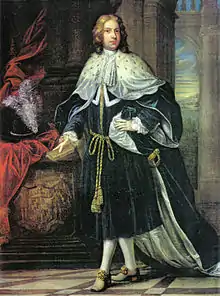

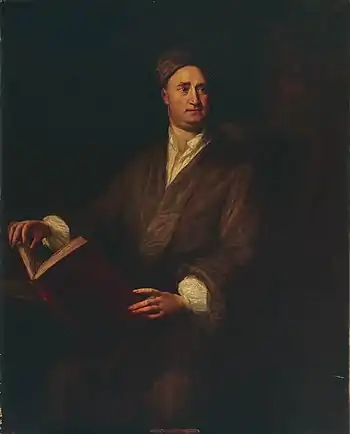

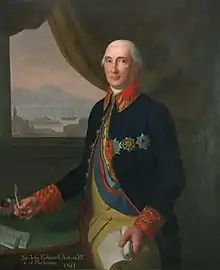
%252C_Countess_of_Derby.jpg.webp)
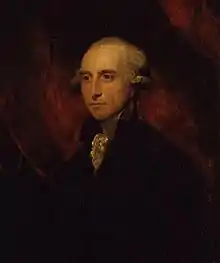





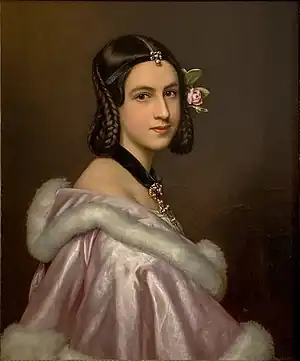





%252C_6th_Duchess_of_Portland%252C_1912.jpg.webp)



